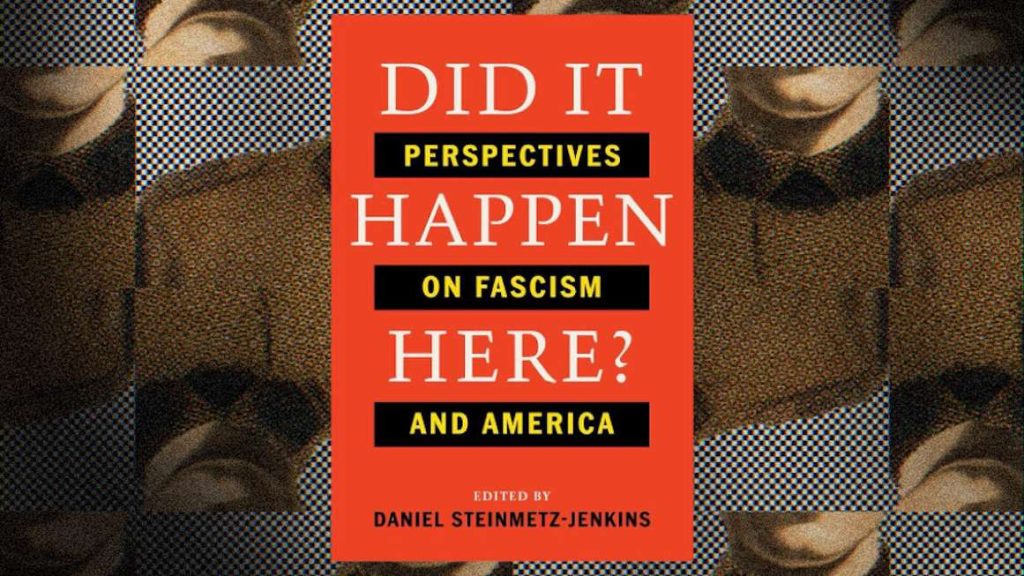Did It Happen Here?: Perspectives on Fascism and America, edited by Daniel Steinmetz-Jenkins, W.W. Norton, 384 pages, $28.99
The debate about what fascism is—and whether America is standing on its precipice—is not merely an academic argument. It guides how many people vote, and even how they think about their neighbors. This debate has been active since 2015 in many political corners of the country, including the left, where liberals, socialists, and everything in between have squabbled over these questions.
For readers not of the left, this debate may come as a surprise, given the narrative dominance enjoyed by corporate liberal outlets, which all seem to agree that fascism is indeed happening here. Seeking to convey the broad strokes of this discussion is a new anthology, Did It Happen Here?, edited by the Wesleyan historian Daniel Steinmetz-Jenkins. The collected volume’s title, a play on Sinclair Lewis’s dystopian novel It Can’t Happen Here, brings together several academic voices to debate whether fascism has, can, or will come to America’s shores.
For the contributors who believe that fascism is indeed here or on its way, the modern populist right and similar movements overseas are fascistic because their political vision hinges on racial hierarchy, nativism, national renewal, authoritarianism, and a disdain for majority rule, all to be enforced by violence and intimidation. Several of these writers argue that America’s history of nativism and racial violence was itself a form of proto-fascism, a history they claim is being resurrected by a new anti-democratic right.
Part III of the volume—”Is Fascism as American as Apple Pie?”—centers on such arguments. The Yale philosopher Jason Stanley highlights the ideological overlaps between eugenics-inspired American immigration laws and the subsequent Nazi extermination policies, among other ideological borrowings. Turning to the present, Stanley then points to the rise of immigration restrictionism, strict electoral laws, and other policies preferred by conservatives as evidence of a throughline in fascistic American thought. “If we think of fascism as a set of practices,” he claims, “it is immediately evident that fascism is still with us.”
Other contributors in the affirmative camp eschew historically rooted arguments and call for an expansive redefinition of the term fascism to match modern political circumstances. Geoff Mann, a geographer at Simon Fraser University, opines that the “problem with demanding a precise definition of fascism is that it exaggerates both the ‘exceptional’ character of fascist politics and the distance between us and its historical calamities.” Leah Feldman and Aamir R. Mufti, both professors of comparative literature, argue that mores ranging from antisemitism to traditionalism to “Orthodox Nationalism” fit the f-word too. For such contributors, the stakes are too high to worry about precision: It’s better to err on the side of antifascist caution and cast an extra-wide rhetorical net.
But not everyone in this book agrees. The dissenters take issue with the comparisons to fascism on technical, operational, and conceptual grounds, noting that the Trumpian right does not share the material, ideological, or organizational capacity displayed by classical European fascism. They point out that the modern American right is not a mass movement reacting to a potent communist party, motivated by the anguish of a lost world war and disciplined by a competent leader who espouses a cohesive ideology.
Several of the dissenters note that the other side leans on contemporary or historical phenomena that are not exclusive to fascism. Some take issue, for example, with Stanley’s argument that fascism hinges on an attitude of “us vs. them,” noting that such adversarial attitudes exist within democratic systems, too. These writers show no sympathy for Trump, but they do not want—in the term of one dissenting contributor, the Yale historian Samuel Moyn—to “abnormalize” him. To do that, they argue, is to conceal that Trump “is quintessentially American, the expression of enduring and indigenous syndromes.” As you may have noticed, that overlaps with some arguments on the other side: the ones that argue that Trumpism is fascist, that Trumpism is in the American grain, and that this is no contradiction because fascism itself is in the American grain. But to writers like Moyn, using the fascist label to describe such movements catastrophizes otherwise normal electoral politics.
On a similar note, the dissenting group points out that the use of the fascist label can, and indeed has, led to abuse of state power at home and abroad. The New York University historian Nikhil Pal Singh’s chapter is especially poignant in this regard. Singh argues that imagining a future civil war is a form of political pornography that distorts the “marbled grain” of American political life, creates an incentive to inflate threats, and expands the security state, a theoretical tradeoff not without its historical precedents. Running parallel to its long history of curtailing left-wing radicalism, the U.S. government has long used the fear of fascism (and its close cousin “extremism”) to curtail fundamental rights, such as speech and association. Such abuses were not merely reserved for card-carrying members of the German American Bund or other fascist organizations, but also ensnared others deemed subversive. Be it the FBI’s covert campaign against the America First Committee, the Federal Communications Commission, and Internal Revenue Service’s regulatory war against the first generation of conservative talk radio, or modern calls for hate speech caveats to the First Amendment, the specter of fascism has long served as a tool to undermine fundamental liberties.
Other contributors warn that the use of the fascist label conceals the material causes of right-wing populism, such as the Iraq War and the economic fallout of the Great Recession, and rehabilitates the politicians responsible for them. (They call this process “Trump washing.”) The University of Washington historian Daniel Bessner and the Rutgers philosopher Ben Burgis argue that the war in Iraq, “extraordinary rendition,” and the general erosion of civil liberties during the George W. Bush presidency mean that “by any reasonable metric,” Bush “inflicted far more damage on the world” than Trump has done.
I think the dissenters have the better case, as fascism has a distinct historical meaning that does not neatly or evenly crudely define the political actors of our time. Classic European fascism did contain elements drawn from classical conservatism, such as the centrality of order and hierarchy, and these ideological pillars do also appear in many modern illiberal political philosophies. But fascism also contained modernist and even revolutionary political and sociological developments, impulses that, according to the paleoconservative historian Paul Gottfried (among many others), sought a “scientifically organized national community“—a far cry from premodern European societies built of competing matrices of political and social authority. Indeed, it was from this modernism that fascism and its most extreme iteration, National Socialism, drew its greatest oppressive aspects, such as its biological and materialist concepts of race and its practice of eugenics.
To make their case, the affirmative camp dehistoricizes fascism, treating it as a buffet, choosing elements that make their case and ignoring those that do not, all the while losing sight of ideological feuds within the modern right that undermine their arguments—fissures over eugenics, for example. Whatever it is that ails modern America, it is not fascism, nor is it socialism; it is something else.
But I also think that even the dissenters are missing some key points, largely because the book is limited to left perspectives. Despite the book’s breadth of contributors, it mostly ignores critiques of fascism, and therefore judgments of Trump’s relationship to it, from classical liberal or traditional conservative viewpoints.
Steinmetz-Jenkins frames the collection by arguing that “the fascism debate is a Rorschach test for understanding what is truly ailing American society.” The contributors’ verdicts mostly rest on whether the right’s current trajectory undermines democracy, a word that frequently devolves into meaning “progressive policy preferences.” Meanwhile, they overlook several aspects of contemporary society whose forms and historical origins resemble historical fascism but exist within the confines of electoral politics. The book’s contributors who argue for the affirmative rarely define fascism as rooted in corporatism, an intrusive security state, an aggressive foreign policy, or the homogenizing and atomizing tendencies of mass society, to cite some aspects of fascist systems that libertarian or conservative critics are likely to highlight. (The contributions by Anton Jäger and Richard J. Evans do touch lightly on some of these elements.)
So there is little here for people who share the libertarian economist Charlotte Twight’s critique of the modern American political economy as a form of “participatory fascism.” Her fellow economist Robert Higgs, who extended the critique, argued that the American political economy, while neither liberal nor socialist, bore many of the corporatist hallmarks of earlier fascist systems, parallels that the government obscures through democratic political rituals that engender “the sense that somehow the people control the government.”
Maybe you don’t agree with such critiques, but if you’re going to debate the question of fascism in modern America, you should at least engage them. To deemphasize them obscures maladies within our body politic that arose long before Donald Trump’s political career and will likely long outlast its end.
The post The F-Word and Its Consequences appeared first on Reason.com.






